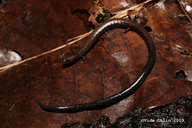|
Oedipina pacificensis Taylor, 1952
Subgenus: Oedipina | family: Plethodontidae subfamily: Hemidactyliinae genus: Oedipina |
| Species Description: Cope, E. D. (1893). "Second addition to the knowledge of the Batrachia and Reptilia of Costa Rica." Proceedings of the American Philosophical Society 31, 333–347. | |
 © 2009 Vide Ohlin (1 of 18) |
|
|
|
Description Description:Oedipina pacificensis is a worm salamander of the family Plethodontidae (the "lungless salamanders"). The body is extremely slender and elongate with short limbs and tiny hands and feet (Savage 2002). Hands and feet are syndactylous with four toes on forelimbs and five toes on hindlimbs. The tail is very long (64% to 72% of total length) (Savage 2002). The snout-vent length of an adult male is generally 26 to 48 mm and adult females are 39 to 51 mm in standard length (Savage 2002). Adults are 108 to 175 mm in total length (Savage 2002). Salamanders of this species have 19 to 20 costal grooves on the sides of its bodies (Savage 2002). This species has a moderately broad head with a bluntly rounded snout (Savage 2002). A sublingual fold is present (Savage 2002). There are 32 to 43 maxillary teeth present and 20 to 26 vomerine teeth (Savage 2002). Oedipina pacificensis is grayish-black in color, often with a whitish area near limb insertions or joints (Savage 2002). This species also has white post-ocular stripes (Taylor 1952). It cannot be distinguished morphologically from O. gracilis and O. uniformis, but there are major genetic differences for O. pacificensis (Good and Wake 1997). Distribution and Habitat Country distribution from AmphibiaWeb's database: Costa Rica
Life History, Abundance, Activity, and Special Behaviors Trends and Threats Possible reasons for amphibian decline General habitat alteration and loss Comments A Spanish-language species account can be found at the website of Instituto Nacional de Biodiversidad (INBio).
References
Bolaños, F., Chaves, G., Savage, J., Wake, D., and Ibáñez, R. (2008). Oedipina pacificensis. In: IUCN 2010. IUCN Red List of Threatened Species. Version 2010.1. www.iucnredlist.org. Downloaded on 07 April 2010. Brame, A. H., Jr. (1968). "Systematics and evolution of the Mesoamerican salamander genus Oedipina." Journal of Herpetology, 2, 1-64. [link] Good, D. A., and Wake, D. B. (1997). ''Phylogenetic and taxonomic implications of protein variation in the Mesoamerican salamander genus Oedipina (Caudata: Plethodontidae).'' Revista de Biología Tropical, 45(3), 1185-1208. Laurencio, D., and Malone, J. H. (2009). ''The amphibians of Parque Nacional Carara, a transitional herpetofaunal assemblage in Costa Rica.'' Herpetological Conservation and Biology, 4(1), 120-131. Savage, J. M. (2002). The Amphibians and Reptiles of Costa Rica:a herpetofauna between two continents, between two seas. University of Chicago Press, Chicago, Illinois, USA and London. Taylor, E.H. (1952). "A review of the frogs and toads of Costa Rica." University of Kansas Science Bulletin, 35(5), 577-942. Originally submitted by: Christine Isabel Javier (first posted 2009-11-04) Edited by: Kellie Whittaker (2022-04-12) Species Account Citation: AmphibiaWeb 2022 Oedipina pacificensis <https://amphibiaweb.org/species/5351> University of California, Berkeley, CA, USA. Accessed Jun 6, 2025.
Feedback or comments about this page.
Citation: AmphibiaWeb. 2025. <https://amphibiaweb.org> University of California, Berkeley, CA, USA. Accessed 6 Jun 2025. AmphibiaWeb's policy on data use. |



 Raffaëlli Account
Raffaëlli Account Map of Life
Map of Life